Impact of Digital Twins and Metaverse on Cities: History, Current Situation, and Application Perspectives
Abstract
1. Introduction
1.1. Research Background
1.2. Research Methods, Procedures, and Significance
2. DC Construction under the Demand of Modernization
2.1. Goals and Ideas of DC
2.2. The Main Content of DC Construction in the IoT Environment
2.3. DC Management Mode Exploration
2.4. A SC Powered by the Metaverse and the DTs
3. The Main Content and Key Technologies of SC Supported by DTs
3.1. Content Architecture and Key Technologies of DTs
3.2. Features of DTs in Realizing SC
3.3. Advantages and Specific Applications of Smart DC
4. The Development Prospect and Technological Breakthrough of DC
4.1. Problems and Countermeasures in the Construction of New SC
4.2. DC 3D Modeling for Fine Management
4.3. Prospect of Digital SC Construction
5. Discussion
6. Conclusions
Author Contributions
Funding
Institutional Review Board Statement
Informed Consent Statement
Acknowledgments
Conflicts of Interest
References
- Frolova, E.E.; Polyakova, T.A.; Dudin, M.N.; Rusakova, E.P.; Kucherenko, P.A. Information security of Russia in the digital economy: The economic and legal aspects. J. Adv. Res. Law Econ. 2018, 9, 89. [Google Scholar] [CrossRef] [PubMed]
- Zahra, S.A. International entrepreneurship in the post Covid world. J. World. Bus. 2021, 56, 101143. [Google Scholar] [CrossRef]
- Amirova, E.F.; Voronkova, O.Y.; Pyurveeva, K.A. Functioning of agroindustrial complex in the conditions of digital economy. Int. J. Mech. Eng. Technol. 2018, 9, 586. [Google Scholar]
- Ashraf, S. A proactive role of IoT devices in building smart cities. Internet Things Cyber-Phys. Syst. 2021, 1, 8–13. [Google Scholar] [CrossRef]
- Feng, H.; Chen, D.; Lv, H. Sensible and secure IoT communication for digital twins, cyber twins, web twins. Internet Things Cyber-Phys. Syst. 2021, 1, 34–44. [Google Scholar] [CrossRef]
- Khan, W.Z.; Rehman, M.H.; Zangoti, H.M.; Afzal, M.K.; Armi, N.; Salah, K. Industrial internet of things: Recent advances, enabling technologies and open challenges. Comput. Electr. Eng. 2020, 81, 106522. [Google Scholar] [CrossRef]
- Avtar, R.; Aggarwal, R.; Kharrazi, A.; Kumar, P.; Kurniawan, T.A. Utilizing geospatial information to implement SDGs and monitor their Progress. Environ. Monit. Assess. 2020, 192, 35. [Google Scholar] [CrossRef]
- Ferronato, N.; Preziosi, G.; Portillo, M.A.G.; Lizarazu, E.G.G.; Torretta, V. Assessment of municipal solid waste selective collection scenarios with geographic information systems in Bolivia. Waste Manag. 2020, 102, 919–931. [Google Scholar] [CrossRef]
- Marzouk, M.; Othman, A. Planning utility infrastructure requirements for smart cities using the integration between BIM and GIS. Sustain. Cities Soc. 2020, 57, 102120. [Google Scholar] [CrossRef]
- Dhanwani, R.; Prajapati, A.; Dimri, A.; Varmora, A.; Shah, M. Smart Earth Technologies: A pressing need for abating pollution for a better tomorrow. Environ. Sci. Pollut. Res. 2021, 28, 35406–35428. [Google Scholar] [CrossRef]
- Sakib, N.H.; Islam, M.; Shishir, M.; Shishir, F.G. National integrity strategy implementation in land administration to prevent corruption in Bangladesh. SN Soc. Sci. 2022, 2, 43. [Google Scholar] [CrossRef] [PubMed]
- Gella, G.W.; Wendt, L.; Lang, S.; Tiede, D.; Hofer, B.; Gao, Y.; Braun, A. Mapping of Dwellings in IDP/Refugee Settlements from Very High-Resolution Satellite Imagery Using a Mask Region-Based Convolutional Neural Network. Remote Sens. 2022, 14, 689. [Google Scholar] [CrossRef]
- Chen, R.; Shen, H.; Lai, Y. A Metaheuristic Optimization Algorithm for energy efficiency in Digital Twins. Internet Things Cyber-Phys. Syst. 2022, 2, 159–169. [Google Scholar] [CrossRef]
- Nguyen, D.D.; Rohacs, J.; Rohacs, D. Autonomous flight trajectory control system for drones in smart city traffic management. ISPRS Int. J. Geo-Inf. 2021, 10, 338. [Google Scholar] [CrossRef]
- Shan, P.; Sun, W. Research on 3D urban landscape design and evaluation based on geographic information system. Environ. Earth Sci. 2021, 80, 597. [Google Scholar] [CrossRef]
- Wu, Y.; Zhang, K.; Zhang, Y. Digital twin networks: A survey. IEEE Internet Things 2021, 8, 13789–13804. [Google Scholar] [CrossRef]
- AlZubi, A.A.; Alarifi, A.; Al-Maitah, M.; Alheyasat, O. Multi-sensor information fusion for Internet of Things assisted automated guided vehicles in smart city. Sustain. Cities Soc. 2021, 64, 102539. [Google Scholar] [CrossRef]
- Khan, S.; Nazir, S.; García-Magariño, I.; Hussain, A. Deep learning-based urban big data fusion in smart cities: Towards traffic monitoring and flow-preserving fusion. Comput. Electr. Eng. 2021, 89, 106906. [Google Scholar] [CrossRef]
- Liu, X.; Li, C. An intelligent urban traffic data fusion analysis method based on improved artificial neural network. J. Intell. Fuzzy Syst. 2019, 37, 4413–4423. [Google Scholar] [CrossRef]
- Agostinelli, S.; Cumo, F.; Guidi, G.; Tomazzoli, C. Cyber-physical systems improving building energy management: Digital twin and artificial intelligence. Energies 2021, 14, 2338. [Google Scholar] [CrossRef]
- Lv, Z.; Chen, D.; Li, J. Novel system design and implementation for the smart city vertical market. IEEE Commun. Mag. 2021, 59, 126–131. [Google Scholar] [CrossRef]
- Eremchenko, E. What is and What is not the Digital Earth? CEUR-WS 2020, 2744, 1–11. [Google Scholar] [CrossRef]
- Hruby, F.; Ressl, R.; de la Borbolla Del Valle, G. Geovisualization with immersive virtual environments in theory and practice. Int. J. Digit. Earth 2019, 12, 123–136. [Google Scholar] [CrossRef]
- Zhu, L.; Hou, W.; Du, X. Digital Earth—From surface to deep: Introduction to the Special issue. Front. Earth Sci. 2021, 15, 491–494. [Google Scholar] [CrossRef]
- Cheng, C.; Dou, J.; Zheng, Z. Energy-efficient SDN for Internet of Things in smart city. Internet Things Cyber-Phys. Syst. 2022, 2, 145–158. [Google Scholar] [CrossRef]
- Novak, A.; Bennett, D.; Kliestik, T. Product decision-making information systems, real-time sensor networks, and artificial intelligence-driven big data analytics in sustainable Industry 4.0. Econ. Manag. Financ. Mark. 2021, 16, 62–72. [Google Scholar]
- Valdenebro, J.V.; Gimena, F.N. Urban utility tunnels as a long-term solution for the sustainable revitalization of historic centres: The case study of Pamplona-Spain. Tunn. Undergr. Space Technol. 2018, 81, 228–236. [Google Scholar] [CrossRef]
- Praharaj, S.; Han, H. Cutting through the clutter of smart city definitions: A reading into the smart city perceptions in India. City Cult. Soc. 2019, 18, 100289. [Google Scholar] [CrossRef]
- Alderete, M.V. Exploring the Smart City indexes and the role of macro factors for measuring cities smartness. Soc. Indic. Res. 2020, 147, 567–589. [Google Scholar] [CrossRef]
- Dameri, R.P.; Benevolo, C.; Veglianti, E.; Li, Y. Understanding smart cities as a glocal strategy: A comparison between Italy and China. Technol. Forecast. Soc. Change 2019, 142, 26–41. [Google Scholar] [CrossRef]
- Riva Sanseverino, E.; Riva Sanseverino, R.; Anello, E. A cross-reading approach to smart city: A european perspective of chinese smart cities. Smart Cities 2018, 1, 26–52. [Google Scholar] [CrossRef]
- Plantin, J.C.; De Seta, G. WeChat as infrastructure: The techno-nationalist shaping of Chinese digital platforms. Chin. J. Commun. 2019, 12, 257–273. [Google Scholar] [CrossRef]
- Zhu, S.; Li, D.; Feng, H. Is smart city resilient? Evidence from China. Sustain. Cities Soc. 2019, 50, 101636. [Google Scholar] [CrossRef]
- Shuai, D.; Qingqing, Y.; Yongmin, X.; Bai, J. Quality inspection and analysis of three-dimensional geographic information model based on oblique photogrammetry. Int. Arch. Photogramm. Remote Sens. Spat. Inf. Sci. 2018, 42, 3. [Google Scholar]
- Cheng, F.; Zhang, J. Research on rain slope stability and digital village construction in mountainous areas based on remote sensing images. Arab. J. Geosci. 2021, 14, 1881. [Google Scholar] [CrossRef]
- Lai, J.S.; Peng, Y.C.; Chang, M.J.; Huang, J.Y. Panoramic Mapping with Information Technologies for Supporting Engineering Education: A Preliminary Exploration. ISPRS Int. J. Geo-Inf. 2020, 9, 689. [Google Scholar] [CrossRef]
- Chen, W. Intelligent manufacturing production line data monitoring system for industrial internet of things. Comput. Commun. 2020, 151, 31–41. [Google Scholar] [CrossRef]
- Rajendran, S.; Srinivas, S.; Grimshaw, T. Predicting demand for air taxi urban aviation services using machine learning algorithms. J. Air Transp. Manag. 2021, 92, 102043. [Google Scholar] [CrossRef]
- Ron-Ferguson, N.; Chin, J.T.; Kwon, Y. Leveraging machine learning to understand urban change with net construction. Landsc. Urban Plan. 2021, 216, 104239. [Google Scholar] [CrossRef]
- Zhang, Y.; Wang, S.; Hermann, A.; Joly, R.; Pathak, J. Development and validation of a machine learning algorithm for predicting the risk of postpartum depression among pregnant women. J. Affect. Disord. 2021, 279, 1–8. [Google Scholar] [CrossRef]
- Zacher, S. Digital Twins by Study and Engineering. South Fla. J. Dev. 2021, 2, 284–301. [Google Scholar] [CrossRef]
- Groshev, M.; Guimarães, C.; Martín-Pérez, J.; Oliva, A. Toward intelligent cyber-physical systems: Digital twin meets artificial intelligence. IEEE Commun. Mag. 2021, 59, 14–20. [Google Scholar] [CrossRef]
- Armstrong, M.P.; Wang, S.; Zhang, Z. The Internet of Things and fast data streams: Prospects for geospatial data science in emerging information ecosystems. Cartogr. Geogr. Inf. Sci. 2019, 46, 39–56. [Google Scholar] [CrossRef]
- Xu, C.; Gao, Z.; Zhang, D.; Zhang, J.J.; Xu, L.; Li, S. Applying Cross-modality Data Processing for Infarction Learning in Medical Internet of Things. IEEE Internet Things J. 2021, 8, 16902–16910. [Google Scholar] [CrossRef]
- Wu, Y.; Lin, S.; Peng, F.; Li, Q. Methods and application of archeological cloud platform for grand sites based on spatio-temporal big data. ISPRS Int. J. Geo-Inf. 2019, 8, 377. [Google Scholar] [CrossRef]
- Yang, C.; Huang, Q.; Li, Z.; Liu, K.; Hu, F. Big Data and cloud computing: Innovation opportunities and challenges. Int. J. Digit. Earth 2017, 10, 13–53. [Google Scholar] [CrossRef]
- Yang, C.; Goodchild, M.; Huang, Q.; Nebert, D.; Raskin, R.; Xu, Y.; Bambacus, M.; Fay, D. Spatial cloud computing: How can the geospatial sciences use and help shape cloud computing? Int. J. Digit. Earth 2011, 4, 305–329. [Google Scholar] [CrossRef]
- Aba, E.N.; Olugboji, O.A.; Nasir, A.; Olutoye, M.A.; Adedipe, O. Petroleum pipeline monitoring using an internet of things (IoT) platform. SN Appl. Sci. 2021, 3, 180. [Google Scholar] [CrossRef]
- Zhao, W.; Chen, J.; Hai, T.; Mohammed, M.N.; Yaseen, Z.M.; Yang, X.; Zain, J.M.; Zhang, R.; Xu, Q. Design of low-energy buildings in densely populated urban areas based on IoT. Energy Rep. 2022, 8, 4822–4833. [Google Scholar] [CrossRef]
- Gilbert, T.; James, P.; Smith, L.; Barr, S.; Morley, J. Topological integration of BIM and geospatial water utility networks across the building envelope. Comput. Environ. Urban Syst. 2021, 86, 101570. [Google Scholar] [CrossRef]
- ElRahman, S.A.; Alluhaidan, A.S. Blockchain technology and IoT-edge framework for sharing healthcare services. Soft Comput. 2021, 25, 13753–13777. [Google Scholar] [CrossRef]
- Raj, M.; Gupta, S.; Chamola, V.; Elhence, A.; Garg, A.; Atiquzzaman, M.; Niyato, D. A survey on the role of Internet of Things for adopting and promoting Agriculture 4.0. J. Netw. Comput. Appl. 2021, 187, 103107. [Google Scholar] [CrossRef]
- Latif, S.; Driss, M.; Boulila, W.; Huma, Z.; Jamal, S.S.; Idrees, Z.; Ahmad, J. Deep Learning for the Industrial Internet of Things (IIoT): A Comprehensive Survey of Techniques, Implementation Frameworks, Potential Applications, and Future Directions. Sensors 2021, 21, 7518. [Google Scholar] [CrossRef] [PubMed]
- Cohen, S. Interconnected sensor networks and digital urban governance in data-driven smart sustainable cities. Geopolit. Hist. Int. Relat. 2021, 13, 97–107. [Google Scholar]
- Gorelova, I.; Dmitrieva, D.; Dedova, M.; Savastano, M. Antecedents and consequences of digital entrepreneurial ecosystems in the interaction process with smart city development. Adm. Sci. 2021, 11, 94. [Google Scholar] [CrossRef]
- Sono, L.P.; Malan, L.P. Fostering Innovation Through Intrapreneurship in the South African Public Service. Aust. J. Publ. Admin. 2021, 56, 936–957. [Google Scholar]
- Gretzel, U.; Koo, C. Smart tourism cities: A duality of place where technology supports the convergence of touristic and residential experiences. Asia Pac. J. Tour. Res. 2021, 26, 352–364. [Google Scholar] [CrossRef]
- Peng, X.; Li, Y.; Si, Y.; Xu, Y.; Liu, X.; Li, D.; Liu, Y. A social sensing approach for everyday urban problem-handling with the 12345-complaint hotline data. Comput. Environ. Urban Syst. 2022, 94, 101790. [Google Scholar] [CrossRef]
- Zhao, C.; Liao, F.; Li, X.; Li, X.; Du, Y. Macroscopic modeling and dynamic control of on-street cruising-for-parking of autonomous vehicles in a multi-region urban road network. Transp. Res. Part C Emerg. Technol. 2021, 128, 103176. [Google Scholar] [CrossRef]
- Llanquileo-Melgarejo, P.; Molinos-Senante, M.; Romano, G.; Carosi, L. Evaluation of the impact of separative collection and recycling of municipal solid waste on performance: An empirical application for Chile. Sustainability 2021, 13, 2022. [Google Scholar] [CrossRef]
- Ghadami, N.; Gheibi, M.; Kian, Z.; Faramarz, M.G.; Naghedi, R.; Eftekhari, M.; Fathollahi-Fard, A.M.; Dulebenets, M.A.; Tian, G. Implementation of solar energy in smart cities using an integration of artificial neural network, photovoltaic system and classical Delphi methods. Sustain. Cities Soc. 2021, 74, 103149. [Google Scholar] [CrossRef]
- Yu, G.; Wang, Y.; Hu, M.; Shi, L.; Mao, Z.; Sugumaran, V. RIOMS: An intelligent system for operation and maintenance of urban roads using spatio-temporal data in smart cities. Future Gener. Comput. Syst. 2021, 115, 583–609. [Google Scholar] [CrossRef]
- Zhao, Y.; Liu, Z.; Qiu, C.; Li, X.; Wang, X.; Hu, Q. Socialized Learning for Smart Cities: Cognitive Paradigm, Methodology, and Solution. IEEE Wirel. Commun. 2021, 28, 200–208. [Google Scholar] [CrossRef]
- Zheng, Y.; Yang, S.; Cheng, H. An application framework of digital twin and its case study. J. Ambient. Intell. Humaniz. Comput. 2019, 10, 1141–1153. [Google Scholar] [CrossRef]
- Nikolakis, N.; Alexopoulos, K.; Xanthakis, E.; Chryssolouris, G. The digital twin implementation for linking the virtual representation of human-based production tasks to their physical counterpart in the factory-floor. Int. J. Comput. Integr. Manuf. 2019, 32, 1–12. [Google Scholar] [CrossRef]
- Phanden, R.K.; Sharma, P.; Dubey, A. A review on simulation in digital twin for aerospace, manufacturing and robotics. Mater. Today Proc. 2021, 38, 174–178. [Google Scholar] [CrossRef]
- Lee, D.; Lee, S.H.; Masoud, N.; Krishnan, M.S.; Li, V.C. Integrated digital twin and blockchain framework to support accountable information sharing in construction projects. Autom. Constr. 2021, 127, 103688. [Google Scholar] [CrossRef]
- Kashef, M.; Visvizi, A.; Troisi, O. Smart city as a smart service system: Human-computer interaction and smart city surveillance systems. Comput. Hum. Behav. 2021, 124, 106923. [Google Scholar] [CrossRef]
- Kang, Y.; Choi, N.; Kim, S. Searching for New Model of Digital Informatics for Human–Computer Interaction: Testing the Institution-Based Technology Acceptance Model (ITAM). Int. J. Environ. Res. Public Health 2021, 18, 5593. [Google Scholar] [CrossRef]
- Banfi, F.; Previtali, M. Human–Computer Interaction Based on Scan-to-BIM Models, Digital Photogrammetry, Visual Programming Language and eXtended Reality (XR). Appl. Sci. 2021, 11, 6109. [Google Scholar] [CrossRef]
- Jiang, H.; Qin, S.; Fu, J.; Zhang, J.; Ding, G. How to model and implement connections between physical and virtual models for digital twin application. J. Manuf. Syst. 2021, 58, 36–51. [Google Scholar] [CrossRef]
- Zhuang, C.; Miao, T.; Liu, J.; Xiong, H. The connotation of digital twin, and the construction and application method of shop-floor digital twin. Robot. Comput.-Integr. Manuf. 2021, 68, 102075. [Google Scholar] [CrossRef]
- Lu, Y.; Liu, C.; Kevin, I.; Huang, H.; Xu, X. Digital Twin-driven smart manufacturing: Connotation, reference model, applications and research issues. Robot. Comput.-Integr. Manuf. 2020, 61, 101837. [Google Scholar] [CrossRef]
- Ding, K.; Chan FT, S.; Zhang, X.; Zhou, G.; Zhang, F. Defining a digital twin-based cyber-physical production system for autonomous manufacturing in smart shop floors. Int. J. Prod. Res. 2019, 57, 6315–6334. [Google Scholar] [CrossRef]
- Yang, X.; Ran, Y.; Zhang, G.; Wang, H.; Mu, Z.; Zhi, S. A digital twin-driven hybrid approach for the prediction of performance degradation in transmission unit of CNC machine tool. Robot. Comput.-Integr. Manuf. 2022, 73, 102230. [Google Scholar] [CrossRef]
- Liu, Z.; Yuan, C.; Sun, Z.; Cao, C. Digital Twins-Based Impact Response Prediction of Prestressed Steel Structure. Sensors 2022, 22, 1647. [Google Scholar] [CrossRef]
- Tran, B.X.; Hoang, M.T.; Vo, L.H.; Le, H.T.; Nguyen, T.H.; Vu, G.T.; Latkin, C.A.; Ho, C.S.H.; Ho, R.C.M. Telemedicine in the COVID-19 pandemic: Motivations for integrated, interconnected, and community-based health delivery in resource-scarce settings? Front. Psychiatry 2020, 11, 921. [Google Scholar] [CrossRef]
- Di Giamberardino, P.; Iacoviello, D.; Papa, F.; Sinisgalli, C. A data-driven model of the COVID-19 spread among interconnected populations: Epidemiological and mobility aspects following the lockdown in Italy. Nonlinear Dyn. 2021, 106, 1239–1266. [Google Scholar] [CrossRef]
- Burdorf, A.; Porru, F.; Rugulies, R. The COVID-19 (Coronavirus) pandemic: Consequences for occupational health. Scand. J. Work. Environ. Health 2020, 46, 229–230. [Google Scholar] [CrossRef]
- Lv, Z.; Chen, D.; Lou, R.; Wang, Q. Intelligent edge computing based on machine learning for smart city. Future Gener. Comput. Syst. 2021, 115, 90–99. [Google Scholar] [CrossRef]
- Vinayakumar, R.; Alazab, M.; Srinivasan, S.; Pham, O.V.; Padannayil, S.K.; Simran, K. A visualized botnet detection system based deep learning for the Internet of Things networks of smart cities. IEEE Trans. Ind. Appl. 2020, 56, 4436–4456. [Google Scholar] [CrossRef]
- Deng, T.; Zhang, K.; Shen, Z.J.M. A systematic review of a digital twin city: A new pattern of urban governance toward smart cities. J. Manag. Sci. Eng. 2021, 6, 125–134. [Google Scholar] [CrossRef]
- Litvinenko, V.S. Digital economy as a factor in the technological development of the mineral sector. Nat. Resour. Res. 2020, 29, 1521–1541. [Google Scholar] [CrossRef]
- Gillani, F.; Chatha, K.A.; Jajja, M.S.S.; Farooq, S. Implementation of digital manufacturing technologies: Antecedents and consequences. Int. J. Prod. Econ. 2020, 229, 107748. [Google Scholar] [CrossRef]
- Tambare, P.; Meshram, C.; Lee, C.C.; Ramteke, R.J.; Imoize, A.L. Performance measurement system and quality management in data-driven Industry 4.0: A review. Sensors 2021, 22, 224. [Google Scholar] [CrossRef]
- Mo, Y.; Ma, S.; Gong, H.; Chen, Z.; Zhang, J.; Tao, D. Terra: A smart and sensible digital twin framework for robust robot deployment in challenging environments. IEEE Internet Things J. 2021, 8, 14039–14050. [Google Scholar] [CrossRef]
- Kuo, Y.H.; Pilati, F.; Qu, T.; Huang, G.Q. Digital twin-enabled smart industrial systems: Recent developments and future perspectives. Int. J. Comput. Integr. Manuf. 2021, 34, 685–689. [Google Scholar] [CrossRef]
- Li, X.; Liu, H.; Wang, W.; Zheng, Y.; Lv, H.; Lv, Z. Big data analysis of the internet of things in the digital twins of smart city based on deep learning. Future Gener. Comput. Syst. 2022, 128, 167–177. [Google Scholar] [CrossRef]
- Wang, S.H.; Tu, C.H.; Juang, J.C. Automatic traffic modelling for creating digital twins to facilitate autonomous vehicle development. Connect. Sci. 2022, 34, 1018–1037. [Google Scholar] [CrossRef]
- Liu, Z.; Meng, X.; Xing, Z.; Shi, G.; Meng, X. Digital Twin-Based Safety Risk Coupling of Prefabricated Building Hoisting. Sensors 2021, 21, 3583. [Google Scholar] [CrossRef]
- Almeaibed, S.; Al-Rubaye, S.; Tsourdos, A.; Avdelidis, N.P. Digital twin analysis to promote safety and security in autonomous vehicles. IEEE Commun. Stand. Mag. 2021, 5, 40–46. [Google Scholar] [CrossRef]
- Fan, C.; Zhang, C.; Yahja, A.; Mostafavi, A. Disaster City Digital Twin: A vision for integrating artificial and human intelligence for disaster management. Int. J. Inf. Manag. 2021, 56, 102049. [Google Scholar] [CrossRef]
- Popa, E.O.; van Hilten, M.; Oosterkamp, E.; Bogaardt, M. The use of digital twins in healthcare: Socio-ethical benefits and socio-ethical risks. Life Sci. Soc. Policy 2021, 17, 6. [Google Scholar] [CrossRef] [PubMed]
- Du, J.; Zhu, Q.; Shi, Y.; Wang, Q.; Lin, Y.; Zhao, D. Cognition digital twins for personalized information systems of smart cities: Proof of concept. J. Manag. Eng. 2020, 36, 04019052. [Google Scholar] [CrossRef]
- Dietz, M.; Pernul, G. Digital twin: Empowering enterprises towards a system-of-systems approach. Bus. Inf. Syst. Eng. 2020, 62, 179–184. [Google Scholar] [CrossRef]
- Fan, Y.; Yang, J.; Chen, J.; Hu, P.; Wang, X.; Xu, J.; Zhou, B. A digital-twin visualized architecture for Flexible Manufacturing System. J. Manuf. Syst. 2021, 60, 176–201. [Google Scholar] [CrossRef]
- Pérez, L.; Rodríguez-Jiménez, S.; Rodríguez, N.; Usamentiaga, R.; García, D.F. Digital twin and virtual reality based methodology for multi-robot manufacturing cell commissioning. Appl. Sci. 2020, 10, 3633. [Google Scholar] [CrossRef]
- Liu, C.; Chen, J. Consuming takeaway food: Convenience, waste and Chinese young people’s urban lifestyle. J. Consum. Cult. 2021, 21, 848–866. [Google Scholar] [CrossRef]
- Munawar, H.S.; Qayyum, S.; Ullah, F.; Sepasgozar, S. Big data and its applications in smart real estate and the disaster management life cycle: A systematic analysis. Big Data Cogn. Comput. 2020, 4, 4. [Google Scholar] [CrossRef]
- Yin, S.; Zhang, N.; Dong, H. Preventing COVID-19 from the perspective of industrial information integration: Evaluation and continuous improvement of information networks for sustainable epidemic prevention. J. Ind. Inf. Integr. 2020, 19, 100157. [Google Scholar] [CrossRef]
- Rathore, M.M.; Paul, A.; Hong, W.H.; Seo, C.; Awan, H.; Saeed, S. Exploiting IoT and big data analytics: Defining smart digital city using real-time urban data. Sustain. Cities Soc. 2018, 40, 600–610. [Google Scholar] [CrossRef]
- Zhu, J.; Wright, G.; Wang, J.; Wang, X. A critical review of the integration of geographic information system and building information modelling at the data level. ISPRS Int. J. Geo-Inf. 2018, 7, 66. [Google Scholar] [CrossRef]
- Yousefi, M.; Ghalehaskar, S.; Asghari, F.B.; Ghaderpoury, A.; Dehghani, M.H.; Ghaderpoori, M.; Mohammadi, A.A. Distribution of fluoride contamination in drinking water resources and health risk assessment using geographic information system, northwest Iran. Regul. Toxicol. Pharmacol. 2019, 107, 104408. [Google Scholar] [CrossRef] [PubMed]
- Wang, H.; Pan, Y.; Luo, X. Integration of BIM and GIS in sustainable built environment: A review and bibliometric analysis. Autom. Constr. 2019, 103, 41–52. [Google Scholar] [CrossRef]
- Zhang, G.; Kou, X. Research and implementation of digital 3D panoramic visual communication technology based on virtual reality. Int. J. Commun. Syst. 2022, 35, e4802. [Google Scholar] [CrossRef]
- Zielinska-Dabkowska, K.M.; Xavia, K. Global Approaches to Reduce Light Pollution from Media Architecture and Non-Static, Self-Luminous LED Displays for Mixed-Use Urban Developments. Sustainability 2019, 11, 3446. [Google Scholar] [CrossRef]
- Ji, B.; Wang, Y.; Song, K.; Li, C.; Wen, H.; Menon, V.G.; Mumtaz, S. A survey of computational intelligence for 6G: Key technologies, applications and trends. IEEE Trans. Ind. Inform. 2021, 17, 7145–7154. [Google Scholar] [CrossRef]
- Li, S.; Li, W.; Lin, Z.; Yi, S. Method for 3D city building continuous transformation based on an improved LOD topological data structure. ISPRS Int. J. Geo-Inf. 2019, 8, 504. [Google Scholar] [CrossRef]
- Escobedo, F.J.; Bottin, M.; Cala, D.; Sandoval Montoya, D.L. Spatial literacy influences stakeholder’s recognition and mapping of peri-urban and urban ecosystem services. Urban Ecosyst. 2020, 23, 1039–1049. [Google Scholar] [CrossRef]
- Han, S.; Dong, X.; Hao, X.; Miao, S. Extracting Objects’ Spatial–Temporal Information Based on Surveillance Videos and the Digital Surface Model. ISPRS Int. J. Geo-Inf. 2022, 11, 103. [Google Scholar] [CrossRef]
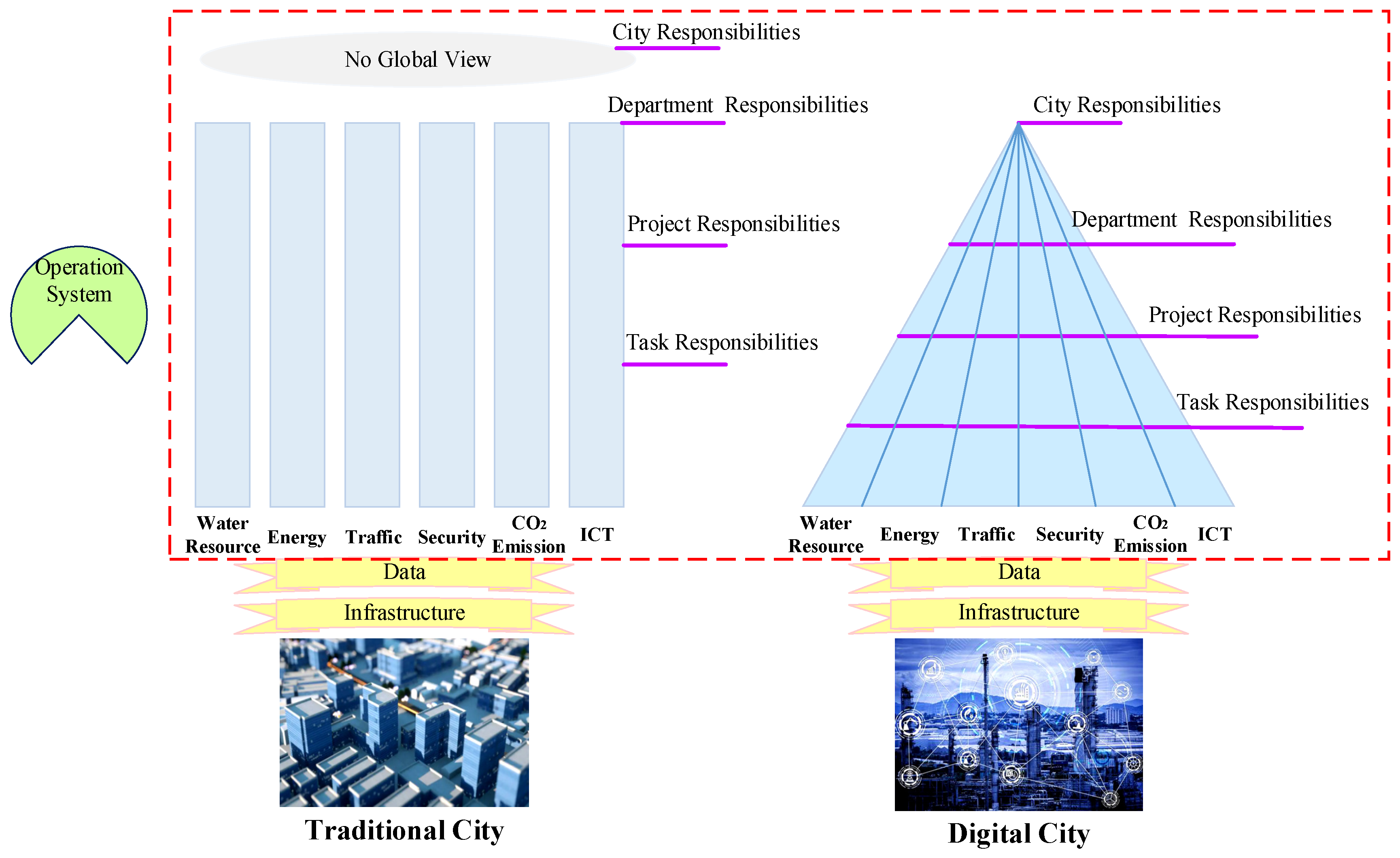
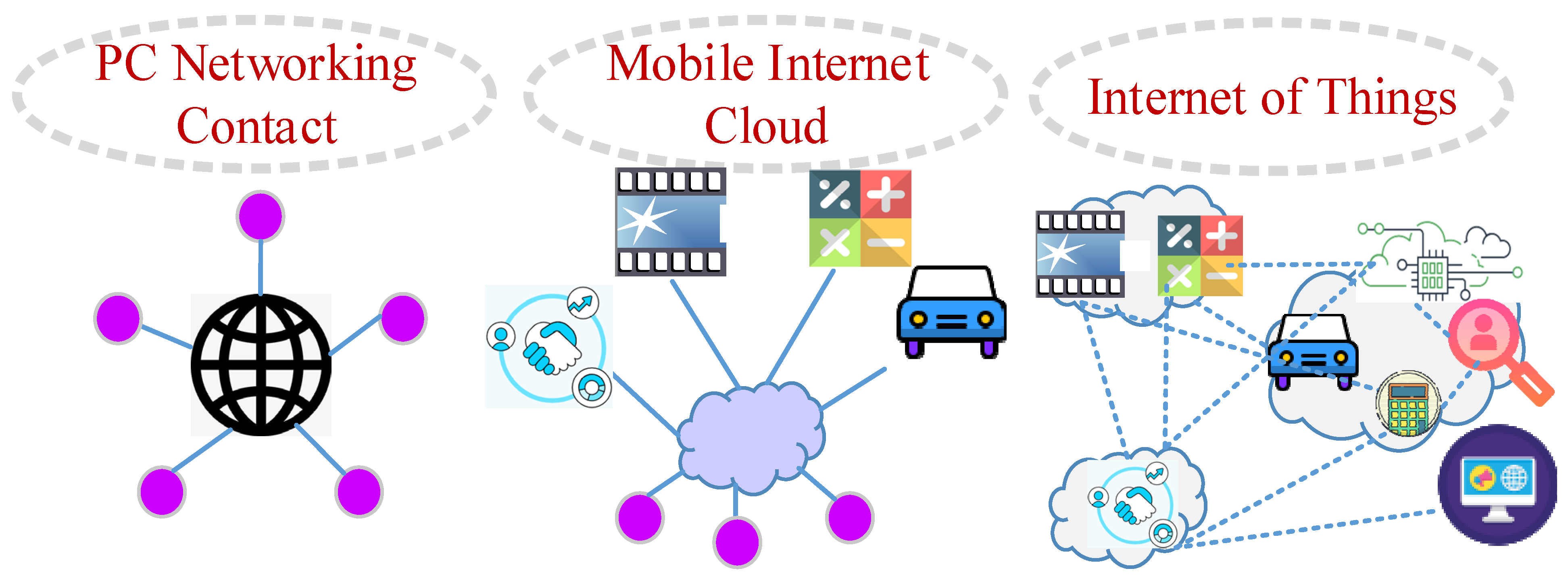
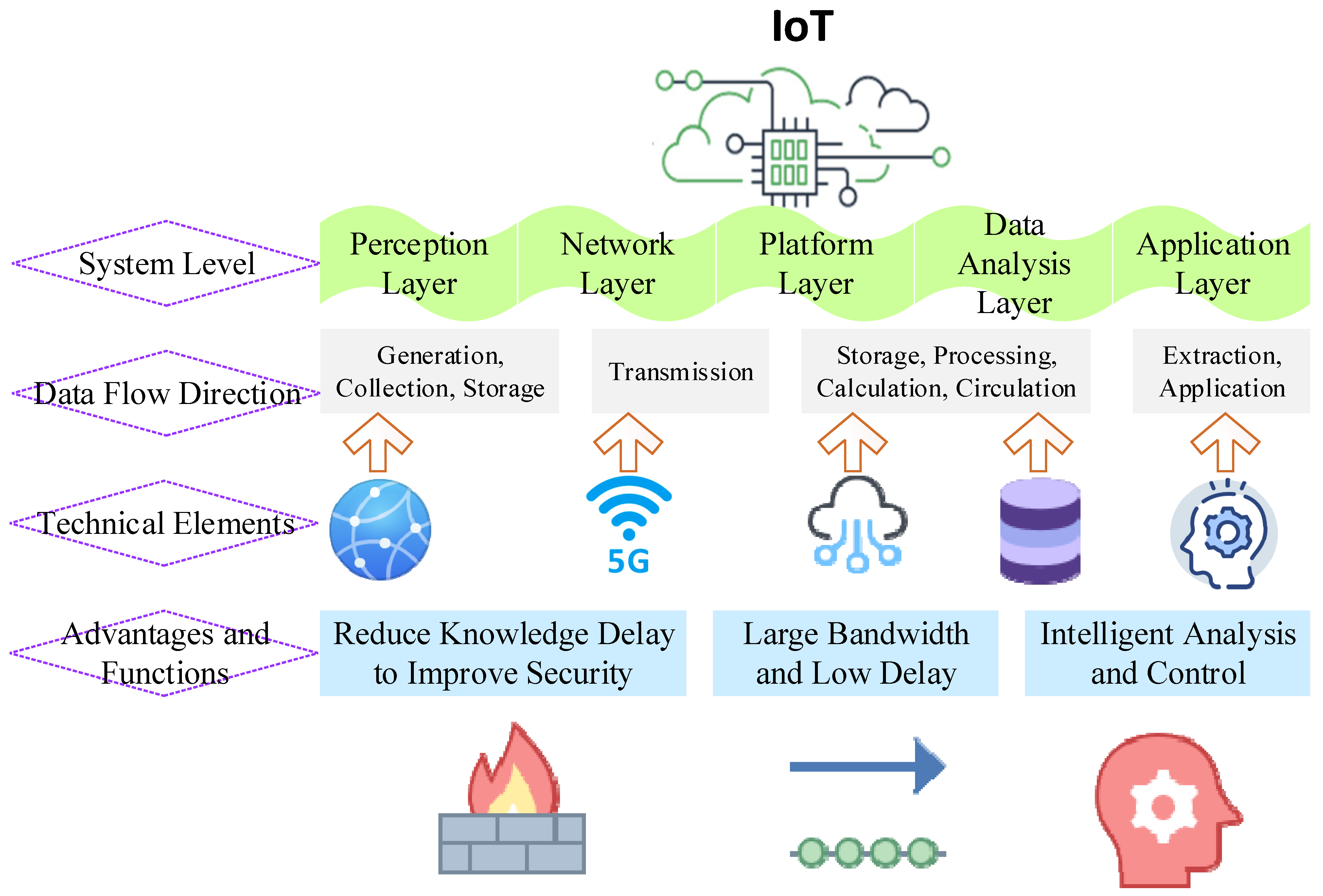
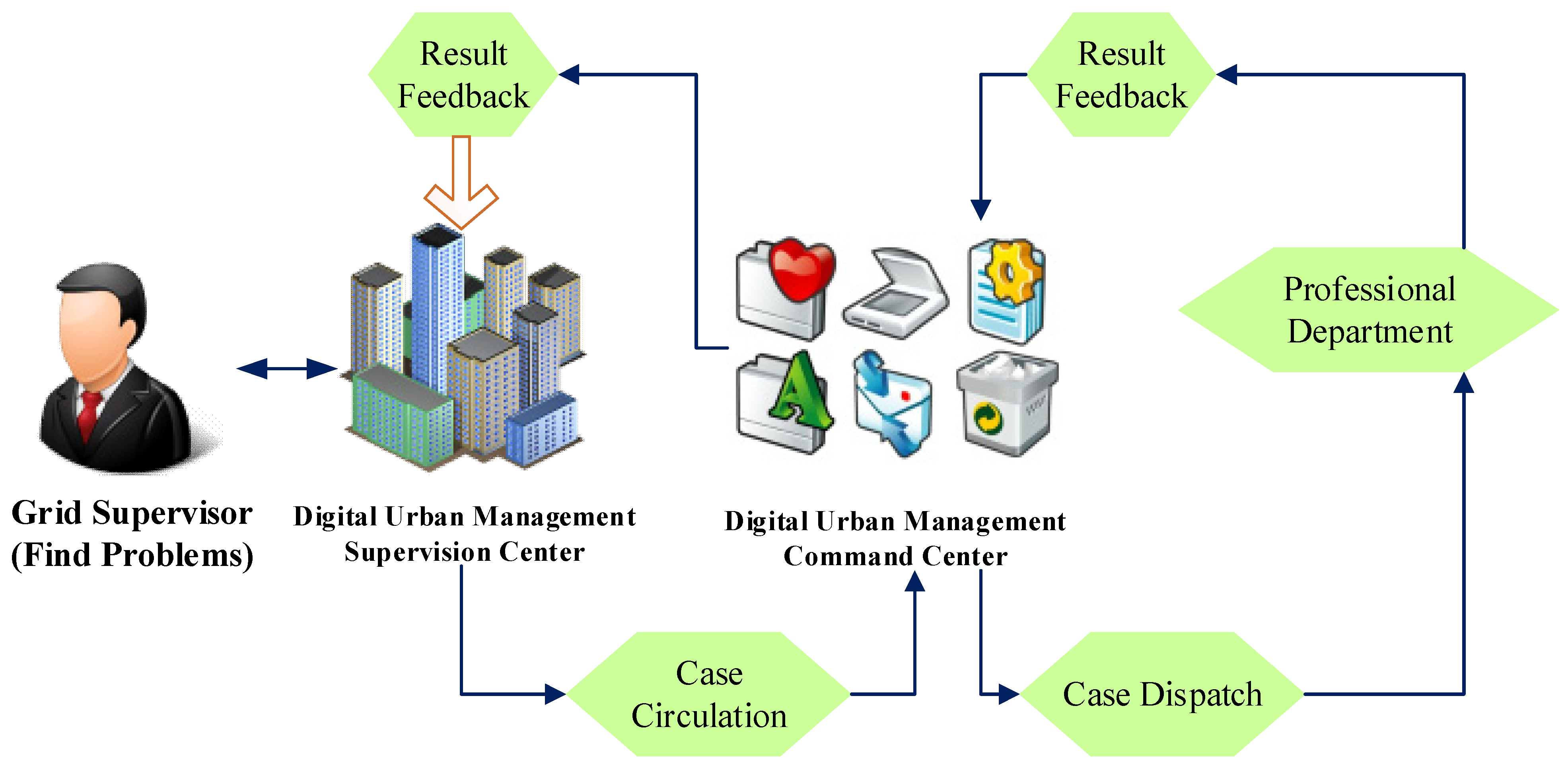
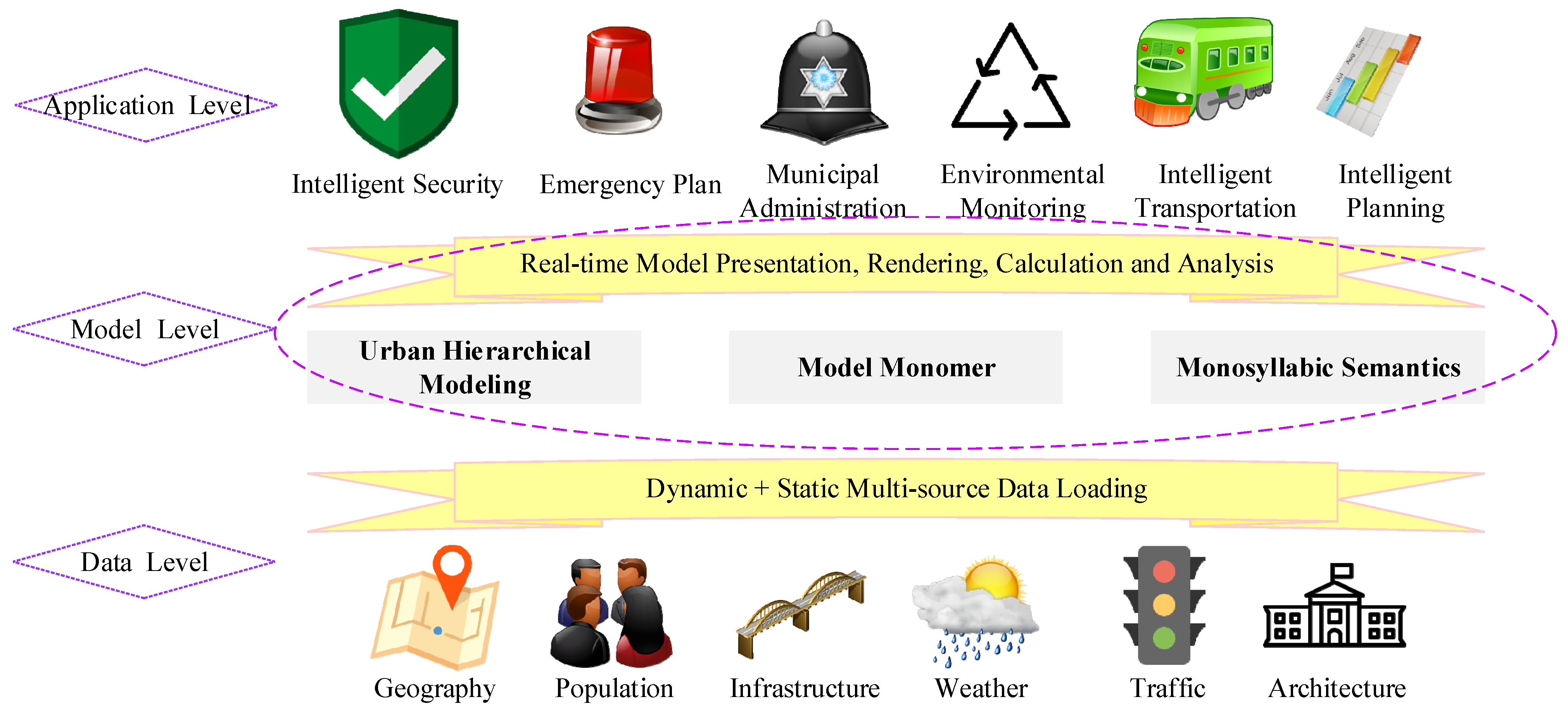
| Traffic Data Fusion Model | This Model Integrates the Data Perceived by Different Traffic Sensors to Form a Unified Traffic Data Flow, including Traffic Flow and Speed |
|---|---|
| Traffic situation analysis | Based on historical data and real-time traffic perception data, this model analyzes and predicts traffic and evaluates traffic, including traffic flow and speed. |
| Signal control model | According to real-time traffic flow data and prediction of traffic flow, this model optimizes intersection signal timing including single point and route and regional optimal time scheme. |
| Traffic planning model | This model is based on the four-stage method of traffic planning and combines the big data of traffic travel and mobile Internet to predict network traffic volume, including traffic volume and service level. |
| Bus optimization model | Based on the bus network, the model predicts bus travel, evaluates the service level of the bus system, and optimizes the bus network, including the evaluation of the service level of the route optimization. |
| Stop-induced model | Based on the prediction of regional parking space occupancy status and parking demand, the model provides regional parking optimization guidance information, including parking guidance information. |
| Intelligent road model | This model forms a road high-resolution dynamic map according to the real-time perception data of intelligent road and assists connected vehicles to drive safely, including road high-resolution dynamic maps and connected safety tips. |
| Micro simulation model of traffic flow | This model combines vehicle dynamics characteristics and driving and the following model to simulate real-time traffic flow, to compare the advantages and disadvantages of different schemes, including scheme comparison and evaluation. |
| Accident analysis model | This model combines the main factors of accidents to analyze traffic accidents and evaluate road safety, including road safety evaluation and analysis of the main causes of accidents. |
| Auxiliary decision model | This model carries out technical and economic analysis and evaluation of transportation improvement projects and recommends projects with excellent cost performance, including technical and economic analysis and evaluation of projects. |
Publisher’s Note: MDPI stays neutral with regard to jurisdictional claims in published maps and institutional affiliations. |
© 2022 by the authors. Licensee MDPI, Basel, Switzerland. This article is an open access article distributed under the terms and conditions of the Creative Commons Attribution (CC BY) license (https://creativecommons.org/licenses/by/4.0/).
Share and Cite
Lv, Z.; Shang, W.-L.; Guizani, M. Impact of Digital Twins and Metaverse on Cities: History, Current Situation, and Application Perspectives. Appl. Sci. 2022, 12, 12820. https://doi.org/10.3390/app122412820
Lv Z, Shang W-L, Guizani M. Impact of Digital Twins and Metaverse on Cities: History, Current Situation, and Application Perspectives. Applied Sciences. 2022; 12(24):12820. https://doi.org/10.3390/app122412820
Chicago/Turabian StyleLv, Zhihan, Wen-Long Shang, and Mohsen Guizani. 2022. "Impact of Digital Twins and Metaverse on Cities: History, Current Situation, and Application Perspectives" Applied Sciences 12, no. 24: 12820. https://doi.org/10.3390/app122412820
APA StyleLv, Z., Shang, W.-L., & Guizani, M. (2022). Impact of Digital Twins and Metaverse on Cities: History, Current Situation, and Application Perspectives. Applied Sciences, 12(24), 12820. https://doi.org/10.3390/app122412820







